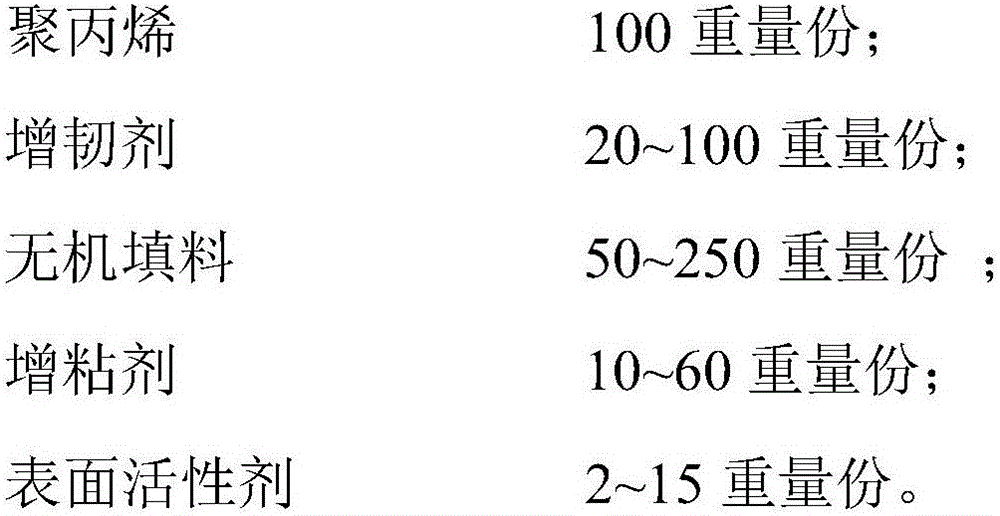Polypropylene composite material capable of realizing 3D (three-dimensional) printing and preparation method thereof
A composite material and 3D printing technology, applied in the field of 3D printing, can solve problems such as the limitations of 3D printing materials, and achieve the effects of simple production process, increased toughness, and improved molding dimensional stability.
- Summary
- Abstract
- Description
- Claims
- Application Information
AI Technical Summary
Problems solved by technology
Method used
Image
Examples
Embodiment 1
[0033] (1) Add 200 parts of 800 mesh calcium carbonate into a high-speed mixer, then add 15 parts by weight of stearic acid, mix and stir for modification, the speed of the mixer is 700rpm, the stirring time is 30 minutes, and the stirring temperature is 60°C;
[0034] (2) be that the modified calcium carbonate of step (1) gained and the polypropylene / butyl rubber TPV of 60 parts by weight, the chlorinated polyethylene of the 30% chlorine content of 50 parts by weight and 100 parts by weight The polypropylene with a melt index of 2g / 10min was added to the internal mixer, and melted and blended at 190°C for 8 minutes to obtain the required 3D printing modified polypropylene composite material;
[0035] (3) The shrinkage rate of the modified polypropylene composite material prepared in the step (2) is 0.6%, which is less than 1%, and no warping occurs during the printing process, and stable printing is possible. Similar to commercially available ABS printing materials, the shrin...
Embodiment 2
[0039] (1) Add 50 parts of 10,000-mesh talc powder into a high-speed mixer, then add 2 parts of titanate, mix and stir for modification, the speed of the mixer is 1000 rpm, the stirring temperature is 60°C, and the stirring time is 20 minutes;
[0040] (2) the modified talcum powder of step (1) gained and the polypropylene / ethylene propylene rubber TPV that is 80 parts by weight, the 50% chlorine content chlorinated polyethylene that is 40 parts by weight and 100 parts by weight Polypropylene with a melt index of 10g / 10min was added to the internal mixer, and melted and blended at 180°C for 6 minutes to obtain the required 3D printing modified polypropylene composite material.
[0041] (3) The shrinkage rate of the modified polypropylene composite material prepared in the step (2) is 0.8%, which is less than 1%, and no warpage occurs during the printing process, and stable printing is possible. Similar to commercially available ABS printing materials, the shrinkage rate of ABS...
Embodiment 3
[0045] (1) Add 100 parts of 5000 mesh calcium carbonate into a high-speed mixer, add 5 parts by weight of stearic acid, the mixer speed is 800rpm, the stirring temperature is 50°C, and the stirring time is 50 minutes; 100 parts of 5000 mesh talcum powder Add it to a high-speed mixer, then add 5 parts of titanate, mix and stir for modification, the speed of the mixer is 800rpm, the stirring temperature is 50°C, and the stirring time is 50 minutes;
[0046](2) the modified calcium carbonate of step (1) gained, modified talcum powder and the polypropylene / ethylene propylene rubber TPV of 40 parts, the chlorinated polyethylene of the 40% chlorine content of 60 parts by weight and 100 parts by weight of polypropylene with a melt index of 15 g / 10 min was added to an internal mixer, and melt-blended at 170° C. for 7 minutes to obtain the desired 3D printing modified polypropylene composite material.
[0047] (3) The shrinkage rate of the modified polypropylene composite material prep...
PUM
| Property | Measurement | Unit |
|---|---|---|
| melt flow index | aaaaa | aaaaa |
| melt flow index | aaaaa | aaaaa |
| melt flow index | aaaaa | aaaaa |
Abstract
Description
Claims
Application Information
 Login to View More
Login to View More - R&D
- Intellectual Property
- Life Sciences
- Materials
- Tech Scout
- Unparalleled Data Quality
- Higher Quality Content
- 60% Fewer Hallucinations
Browse by: Latest US Patents, China's latest patents, Technical Efficacy Thesaurus, Application Domain, Technology Topic, Popular Technical Reports.
© 2025 PatSnap. All rights reserved.Legal|Privacy policy|Modern Slavery Act Transparency Statement|Sitemap|About US| Contact US: help@patsnap.com



